Top News
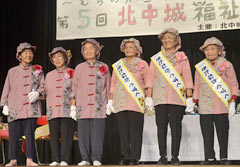
October 30, 2013 Ryukyu Shimpo
Three aged women were chosen as Kitanakagusuku Longevity Beauty Queens 2014 in the village welfare festival on October 26. This event aims to let people know that the village has the longest female lifespan in Japan. Ninety-five-year-old Hatsu Higa, 94-year-old Tsuru Sternberg and 82-year-old Hideko Higa won awards in the pageant. Hatsu was selected as the “best woman having the time of her life,” Tsuru as the “top woman with a volunteer spirit” and Eiko as the “most robust woman.” Over the next year, they will take part in community events to promote healthy longevity.
According to the survey of the Ministry of Health, Labour and Welfare, in 2013 Kitanakagusuku has the longest-living women in Japan for the second time since the previous survey was carried out in 2008. The village office started the event in 2010 to let people throughout Japan know about the village’s outstanding record of longevity. The three aged women are fourth-generation Longevity Beauty Queens. They received their awards from Mayor Kunio Arakaki and the beauty queen sashes from their predecessors. Many villagers enjoyed the festival program, including a children’s dance, a karate performance and a health check.
(English translation by T&CT, Mark Ealey)
Go to Japanese
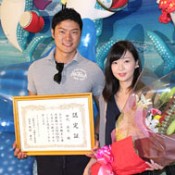
October 24, 2013 Ryukyu Shimpo
On October 23, the Okinawa Churaumi Aquarium welcomed Naohiro Tashiro as its 30 millionth visitor. Visiting the aquarium for the first time with his girlfriend Chisato Mizuta from Tokyo, he received a commemorative certificate and gift from curator Hirokazu Miyahara. Tashiro said, “I’m happy to be here on the day this is being commemorated and I would like to come again on our honeymoon.” At the ceremony many other visitors congratulated the couple for their good luck.
The aquarium was opened in November 2002, with the total number of visitors reaching 30 million in the 11 years since then. For the past few years, about 2.8 million people have visited the aquarium each year.
(English translation by T&CT, Hitomi Shinzato and Mark Ealey)
Go to Japanese
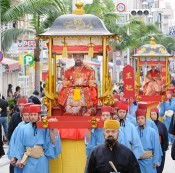
October 28, 2013 Ryukyu Shimpo
The Ryukyu Dynasty procession was held in Kokusai Street, Naha on October 27, the third day of the Shurijo Castle Festival. Reenacting the colorful event from the Ryukyu Dynasty almost one thousand people took part in the procession, including those in the roles of king and queen, sapposhi or envoy of the Chinese Emperor. According to the organizers, about 30,800 people, including roadside spectators, enjoyed traditional arts such as ryubu, eisa dance as well as the standard-bearer’s performance.
Mitsuko Yoda from Aichi Prefecture said, “I timed my visit so I would be here for the Shurijo Castle Festival. I am really glad to be able to watch the powerful eisa close up.”
(English translation by T&CT, Mark Ealey)
Go to Japanese
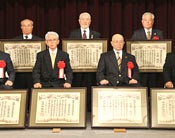
October 24, 2013 Ryukyu Shimpo
The Ryukyu Shimpo newspaper held the 5th Service Awards Ceremony for Okinawan Karate and Traditional Martial Arts at Pacific Hotel Okinawa in Naha on October 23. Seven people who have contributed to passing on and developing karate received award certificates.
Choko Kiyuna (Shorin-ryu), Minoru Higa (Shorin-ryu), Takeshi Miyagi (Shorin-ryu), Koei Teruya (Goju-ryu), Masatsune Chinen (Goju-ryu), Kosuke Yonamine (Shohei-ryu) and Naonobu Ahagon (traditional martial arts) received awards.
Okinawa Vice Governor Kurayoshi Takara spoke in Governor Hirokazu Nakaima’s place, saying, “These seven people have worked hard to pass on karate and traditional martial arts. They have also contributed to nurturing young people and promoting international exchange.”
Representing the recipients, Choko Kiyuna said, “We will strive to pass on karate and traditional martial arts to the next generation and will work hard to honor the award.” The Service Awards Ceremony for Okinawan Karate and Traditional Martial Arts was established in 1993 to mark the 100th anniversary of the establishment of the Ryukyu Shimpo. The company now presents the award every five years, with this year’s ceremony also commemorating the newspaper’s 120th anniversary.
(English translation by T&CT, Lima Tokumori and Mark Ealey)
Go to Japanese

Go To Video

October 28, 2013 Ryukyu Shimpo
The number of the road accidents involving Ryukyu long-haired rats is increasing, claiming the lives of 13 animals so far this year.
Experts warn that this year’s figure could possibly reach 25, exceeding the highest number recorded in 2011 in which 24 were killed on roads.
Ichihito Yamamoto, a native conservation ranger at the Wildlife Conservation Center of the Ministry of the Environment said, “When people are out driving, I would like them to look out for these animals.”
There were three accidents in September and another three in October. Most have been on Prefectural Road No. 2 in Kunigami, but some have occurred outside the area in which the center has issued an alert to drivers.
Because the rat is nocturnal, the accidents tend to occur late in the afternoon when people are on their way home, or in the early morning.
The rats become active during their breeding season from autumn to winter, so the number of animals wandering onto roads increases. Yamamoto said, “We will need to be careful when driving after next spring when young rats are out there moving around.”
(English translation by T&CT, Mark Ealey)
Go to Japanese
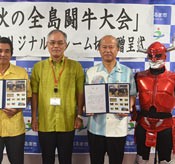
October 25, 2013 Ryukyu Shimpo
On October 23, the Okinawa branch of Japan Post released postage stamps commemorating the 100th All Okinawa Bullfighting Tournament. The stamps depict bullfighting scenes mainly from the works of freelance photographer Yukie Kudaka, who is from Uruma City and has published a photo book entitled “The Bullfighting Woman.” One sheet contains ten 80-yen stamps and a total of only 1,000 sheets are available in post offices in Uruma, Okinawa, Kin, Onna and Ginoza.
On October 23 at the Uruma Municipal Office, Akio Higa, the postmaster at the Ishikawa Post Office, presented the commemorative postage stamps to Uruma City Mayor Toshio Shimabukuro and Masakazu Kochi, the chairman of the Okinawa Prefectural Bullfighting Federation. They reminisced about popular bulls such as “Yukari-go” that competed during the half-century history of bullfighting. The tournament has now been held 100 times.

Postage stamps commemorating the 100th All Okinawa Bullfighting Tournament.
Kochi talked about the history of bullfighting and vowed that they would treasure it and continue to promote bullfighting. Akio Higa, the local postmaster said, ” We would like to put regional traditional culture on display by selling these postage stamps. So, I will be very pleased if more people come to appreciate this culture.”
Mayor Shimabukuro said, “In the past, bullfighting was followed by a limited sector of society, but now it is widely accepted by both young and old alike. These bullfighting commemorative stamps tell the story of changing times.”
(English translation by T&CT, Mark Ealey)
Go to Japanese
October 25, 2013 Ryukyu Shimpo
Public relations and tourism promotion company SB Japan started promoting Okinawa tourism at more than 300 movie theaters nationwide on October 24. It advertises on screens and sells Okinawan products in the theater lobbies. They aim to lift awareness of specialty products by providing tourism information and encouraging local revitalization.
The company targets local governments, tourism associations, travel agencies and businesses in the tourism industry such as hotels. They will work with Cine Bridge, which handles promotion services in movie theaters.
SB Japan moved its main office from Hyogo Prefecture to Okinawa in August. To date, it has worked on promotions for local governments and tourism associations inside and outside of Japan, such as for Gunma Prefecture and the Australia Government Tourism Division. Working with cafes in theaters, the company aims to sell products and carry out advertising. Another idea is to put advertising in movie-related free magazines, which they give out 60,000 copies of a month at 91 movie theaters nationwide. With children’s movies they promote tourist spots for children, and they seek to achieve a more effective promotion when promoting something that matches the movie. SB Japan president, Hideki Nakamoto, said, “We can run this differently from other promotions. We can also advertise in a way that matches the characteristics of local towns. We want to run effective promotions.”
For further information, please email SB Japan at info@sb-ja.jp.
(English translation by T&CT, Megumi Chibana and Mark Ealey)
Go to Japanese
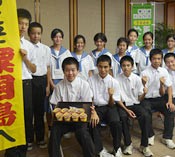
October 22, 2013 Ryukyu Shimpo
Aguni Junior High School students have created ice cream containing salt and gluey millet fried dough cookies made in Aguni. The students reported their achievement to Okinawa Governor Hirokazu Nakaima at the Prefectural Office on October 21.
The students studied the planning, development and sales of the ice cream during and after regular classes and worked on making the ice cream into a saleable item.
Fourteen-year-old Yuta Yonamine said, “We are confident about this product that tastes like salt and the brown sugar in karinto fried dough cookies.”
After tasting the ice cream Governor Nakaima said, “It was delicious and has a rich taste.” He went on to comment, “Working is enjoyable. I want young people to try doing all sorts of different things.”
The students sold their products at the Co-operative Union branches of Apple Town, Shuri and Kokuba from 10:00 a.m. to 6:00 p.m. on October 23. The ice cream sells for 250 yen with limited sales of a total of 700 units.
(English translation by T&CT, Mark Ealey)
Go to Japanese
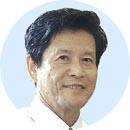
October 23, 2013 Takumi Takimoto of Ryukyu Shimpo
Okinawan researchers have found that liquid extracted from shell ginger contains a compound that slows aging and reduces wrinkles. Okinawan people have been consuming the liquid from ancient times. Shinkichi Tawada, professor in the Faculty of Agriculture of University of the Ryukyus and other researchers made this discovery, which they announced at the Agribusiness Creation Fair held in Tokyo.
The researchers are now applying for a patent for their discovery and Tawada has suggested that Okinawa create a sextiary sector using the flower.
When the research team compared the life expectancy of eelworms that received the liquid with those that did not, they found that the former group lived 22.6 percent longer. They published their discovery in Bioscience, Biotechnology, and Biochemistry this February.
In other studies, the researchers found that dehydrokawain and other compounds contained in the flower block the enzyme related to skin diseases. Okinawan people have traditionally eaten rice cake wrapped with shell ginger in winter.
Studies show that dehydrokawain prevents hyaluronic acid from degrading. The leaves, roots, seeds and stems of the flower provide essential oil, the compound and fiber. Okinawa industry will be able use them in medicines, antiseptic agents, insect repellents and papers that will help promote and create various local businesses.
Tawada said, “As the life expectancy of Okinawan people declines, we need to take another look at traditional foods. Many people see shell ginger as a raw material for cosmetics, but the flower could possibly produce health foods and medicines with a high value. Okinawa will be able to use the flower to create a sextiary sector.”
(English translation by T&CT, Mark Ealey)
Go to Japanese
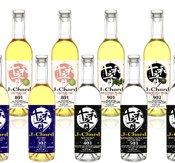
October 22, 2013 Fumitetsu Jahana of the Ryukyu Shimpo
In an attempt to target overseas markets, Zuisen Distillery Co., Ltd (Naha) and five breweries in Kyushu are developing a joint brand called “Towane J-Chord.” In addition to awamori, the breweries plan to produce a joint brand including quality labels of sake, barley and potato shochu, and liqueurs. The joint brand will help the products become popular with foreign consumers. Negotiations with major American retailers are progressing and they plan to sell the products from next year. Zuisen and other companies, including Ogashuzo (Fukuoka Prefecture), Kyoya Distiller & Brewer Co., Ltd (Miyazaki Prefecture), Chiyonosono Co. (Kumamoto Prefecture), Madonoume Co., Ltd (Saga Prefecture), Yatsushika Brewery Co., Ltd (Oita Prefecture), have created the Towane Group, which also serves as the brand name.
Tokyo-based marketing company Oval One Co., Ltd has coordinated this project. The breweries have spent three years preparing, including applying to relevant authorities in the United States.
They have classified the products according to the code of music. Shochu and sake have a classification code between 100 and 900, assigned by the ratio of the main raw material, such as polished rice. Zuisen Distillery plans to commercialize five-year-old liquor kusu as code 401 and awamori as 404. Plum wine with awamori as its base has now cleared the label examination and is on its way to being available for sale.
Zuisen has been exploring foreign market, including the United States, but at this stage customers are mostly Japanese food restaurants. Japanese people living there have been the ones ordering awamori, so expanding the market represents a challenge for the company.
Manabu Sakumoto, the president of Zuisen, said, “So much of our marketing depends on the Japanese network. By using the joint brand we would like to sell more Japanese liquor in a way that attracts local people in foreign countries.”
(English translation by T&CT, Mark Ealey)
Go to Japanese

October 21, 2013 Ryukyu Shimpo
The World Masters Athletics Championships 2013 have been held in Porto Alegre, Brazil. On October 19, Takeshi Fukuzato, originally from Kumejima, won a silver medal the men’s age 40-44 100-meter dash with a time of 11.12 seconds. Former Japanese decathlon champion and TV personality So Takei came fourth, with a time of 11.15 seconds.
This was the first time for Fukuzato to take part in the world championships. He said, “Competing in the championships has made me grow stronger.” In semi-finals, Fukuzato came fifth, afterwards saying, “That race did not go as I intended.” In the final, he decided to run in a more relaxed way, which allowed him to run faster at the end of the race.
Many people helped Fukuzato take part in the championships. Friends and supporters back in his hometown of Kumejima Island donated money for the long trip from Okinawa to Brazil. Members of his family, his coach and the people at work also helped him take part.
On top of managing a call center, teaching at a professional school and working at a sports club, Fukuzato took time from his busy schedule to train for the championship. The 42-year-old, who intends to continue to push himself, said, “By winning a silver medal, I hope that I have done something to express my gratitude to those who supported me.”
(English translation by T&CT, Mark Ealey)
Go to Japanese












 Webcam(Kokusai Street)
Webcam(Kokusai Street)


